
The Accipitridae is one of the four families within the order Accipitriformes, and is a family of small to large birds of prey with strongly hooked bills and variable morphology based on diet. They feed on a range of prey items from insects to medium-sized mammals, with a number feeding on carrion and a few feeding on fruit. The Accipitridae have a cosmopolitan distribution, being found on all the world's continents and a number of oceanic island groups. Some species are migratory. The family contains 256 species which are divided into 12 subfamilies and 75 genera.
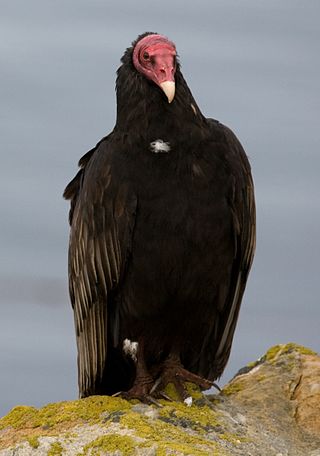
Cathartidae, known commonly as New World vultures or condors, are a family of birds of prey consisting of seven extant species in five genera. It includes five extant vultures and two extant condors found in the Americas. They are known as "New World" vultures to distinguish them from Old World vultures, with which the Cathartidae does not form a single clade despite the two being similar in appearance and behavior as a result of convergent evolution.

The lappet-faced vulture or Nubian vulture is an Old World vulture belonging to the bird order Accipitriformes, which also includes eagles, kites, buzzards and hawks. It is the only member of the genus Torgos. It is not closely related to the superficially similar New World vultures, and does not share the good sense of smell of some members of that family of birds.

The scoters are stocky seaducks in the genus Melanitta. The drakes are mostly black and have swollen bills, the females are brown. They breed in the far north of Europe, Asia, and North America, and winter further south in temperate zones of those continents. They form large flocks on suitable coastal waters. These are tightly packed, and the birds tend to take off together. Their lined nests are built on the ground close to the sea, lakes or rivers, in woodland or tundra. These species dive for crustaceans and molluscs.

Gyps is a genus of Old World vultures that was proposed by Marie Jules César Savigny in 1809. Its members are sometimes known as griffon vultures. Gyps vultures have a slim head, a long slender neck with downy feathers, and a ruff around the neck formed by long buoyant feathers. The crown of their big beaks is a little compressed, and their big dark nostrils are set transverse to the beak. They have six or seven wing feathers, of which the first is the shortest and the fourth the longest.

Coragyps is a genus of New World vulture that contains the black vulture (Coragyps atratus) and two extinct relatives.
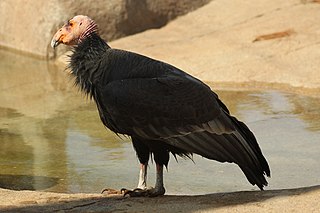
Gymnogyps is a genus of New World vultures in the family Cathartidae. There are five known species in the genus, with only one being extant, the California condor.
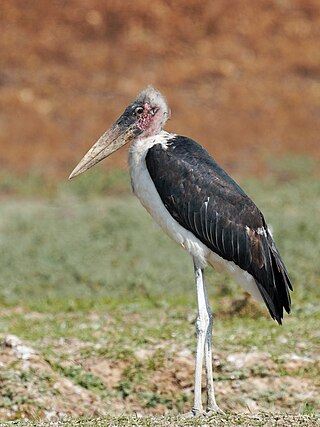
Leptoptilos is a genus of very large tropical storks, commonly known as adjutants. The name means thin (lepto) feather (ptilos). Two species are resident breeders in southern Asia, and the marabou stork is found in Sub-Saharan Africa.
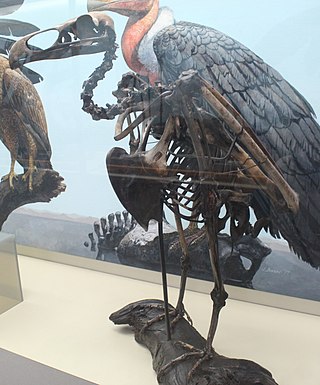
Teratornis was a genus of huge North American birds of prey—the best-known of the teratorns—of which, two species are known to have existed: Teratornis merriami and Teratornis woodburnensis. A large number of fossil and subfossil bones, representing more than 100 individuals, have been found in locations in California, Oregon, southern Nevada, Arizona, and Florida, though most are from the Californian La Brea Tar Pits. All remains except one Early Pleistocene partial skeleton from the Leisey Shell Pit near Charlotte Harbor, Florida date from the Late Pleistocene, with the youngest remains dating from the Pleistocene–Holocene boundary.
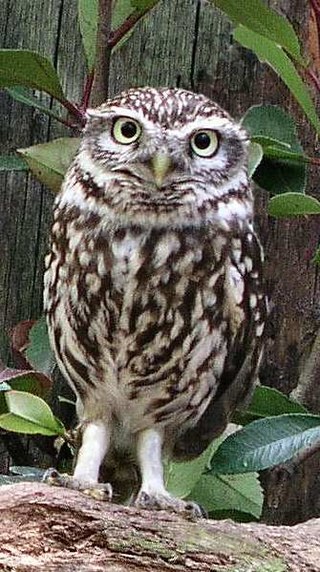
Athene is a genus of owls, containing nine living species, depending on classification. These birds are small, with brown and white speckles, yellow eyes, and white eyebrows. This genus is found on all continents except for Australia, Antarctica, and Sub-Saharan Africa. An evolutionary radiation of 4 species is also present in the Solomon Islands.

Buteogallus is a genus of birds of prey in the family Accipitridae. All members of this genus are essentially neotropical, but the distribution of a single species extends slightly into the extreme southwestern United States. Many of the species are fond of large crustaceans and even patrol long stretches of shore or riverbank on foot where such prey abounds, but some have a rather different lifestyle. Unlike many other genera of raptor, some members are referred to as "hawks", and others as "eagles".

Triaenops is a genus of bat in the family Rhinonycteridae. It is classified in the tribe Triaenopini, along with the closely related genus Paratriaenops and perhaps the poorly known Cloeotis. The species of Paratriaenops, which occur on Madagascar and the Seychelles, were placed in Triaenops until 2009. Triaenops currently contains the following species:

Caracara is a genus in the family Falconidae and the subfamily Polyborinae. It contains one extant species, the crested caracara, and one recently extinct species, the Guadalupe caracara. The crested caracara had in recent years been split into a northern species C. cheriway and a southern species C. plancus, but the South American Classification Committee of the American Ornithological Society has voted to again merge the two, retaining C. plancus as the crested caracara. The taxonomists of the International Ornithologists' Union have also merged them.
Desmodus draculae is an extinct species of vampire bat that inhabited Central and South America during the Pleistocene, and possibly the early Holocene. It was 30% larger than its living relative the common vampire bat. Fossils and unmineralized subfossils have been found in Argentina, Mexico, Ecuador, Brazil, Venezuela, Belize, and Bolivia.

Pachystruthio is a genus of extinct bird which lived in Eurasia from the Late Pliocene to the Middle Pleistocene. Its fossils have been found in Hungary, Greece Crimea, Georgia, and China. The genus contains three species: P. pannonicus, P. dmanisensis, and P. transcaucasicus, which were all formerly placed with the ostrich genus, Struthio. An incomplete femur from the Nihewan Formation (China) has been assigned to Pachystruthio indet. P. dmanisensis has been estimated standing 3.5 meters tall and weighing up to 450 kg (990 lb), making it much larger than the modern ostrich and one of the largest known birds.

Megalochelys is an extinct genus of tortoises that lived from the Miocene to Pleistocene. They are noted for their giant size, the largest known for any tortoise, with a maximum carapace length of over 2 m (6.5 ft) in M. atlas. The genus ranged from western India and Pakistan to as far east as Sulawesi and Timor in Indonesia, though the island specimens likely represent distinct species.

Cercopithecoides is an extinct genus of colobine monkey from Africa which lived during the latest Miocene to the Pleistocene period. There are several recognized species, with the smallest close in size to some of the larger extant colobines, and males of the largest species weighed over 50 kilograms (110 lb).
Cryptogyps is an extinct genus of Old World vulture from the Pleistocene of Australia. It was relatively small for a vulture but still larger than the extant wedge-tailed eagle. Originally described as an eagle in 1905, in 2022 it was reidentified as a vulture, the first known example from the continent. Phylogenetic analysis suggests it either being a sister species to the extant, widespread Eurasian vulture genus Gyps or as a more basal member of the subfamily. The identification of Cryptogyps as a vulture solves a longstanding mystery about the lack of specialized lineages of large scavenging birds in Australia despite being present on every other continent aside from Antarctica. It is likely that Cryptogyps went extinct towards the end of the Pleistocene due to the disappearance of the megafauna it depended on for carrion. The genus contains a single species, C. lacertosus.

Dynatoaetus is an extinct genus of large bird of prey from the Pleistocene of Australia. It is among the largest known raptors of the region, second only to the Haast's eagle of New Zealand, with estimates suggesting a weight of up to 12 kg (26 lb). Although most closely related to modern vultures, it shows clear adaptations towards an active predatory lifestyle in the form of robust, powerful talons. This may either hint at it retaining these ancestral features from the closely related serpent eagles or show that it convergently evolved these features as it took on a similar lifestyle. Due to their size and robust bones, it is thought that Dynatoaetus would have been capable of taking large prey items like kangaroos, giant wombats and flightless birds. There are two species within the genus, the type species Dynatoaetus gaffae and the somewhat smaller Dynatoaetus pachyosteus, both of which inhabited the same part of Australia at the same time.
Torgos platycephalus is an extinct species of Torgos that lived in Azerbaijan during the Pleistocene epoch.

















